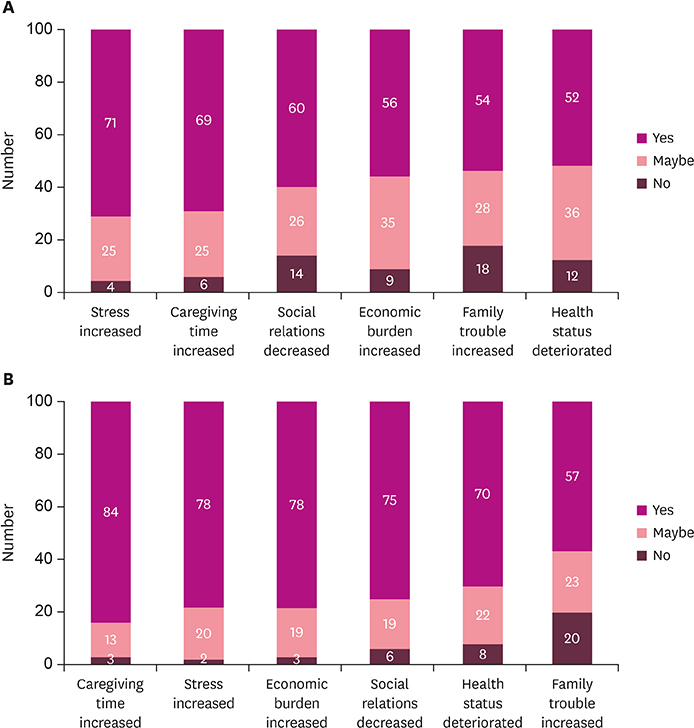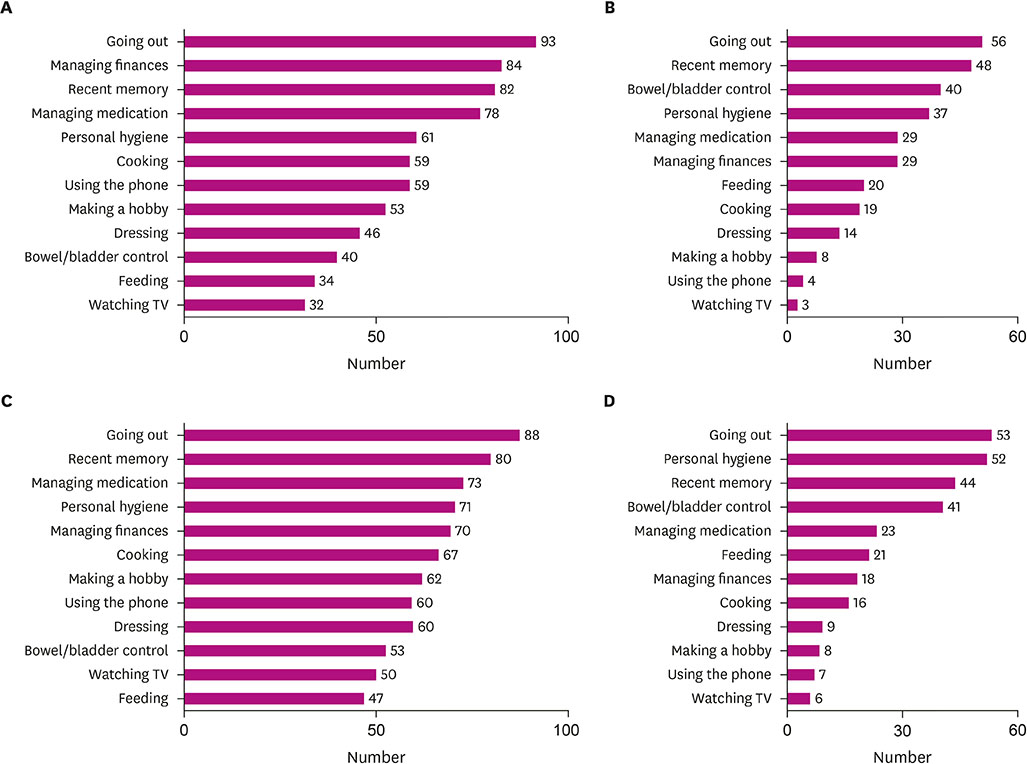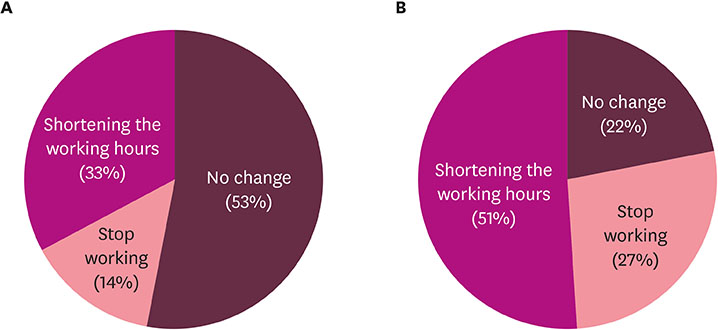Dement Neurocogn Disord.
2019 Mar;18(1):1-9. 10.12779/dnd.2019.18.1.1.
Survey of Current Status and Cognition of Activities of Daily Living in Dementia Patients: the 2018 “Il-sang-ye-chan†Campaign
- Affiliations
-
- 1Department of Neurology, Hanyang University Guri Hospital, Guri, Korea.
- 2Department of Neurology, Hallym University Sacred Heart Hospital, Hallym University College of Medicine, Anyang, Korea.
- 3Department of Neurology, Konkuk University Medical Center, Seoul, Korea.
- 4Department of Neurology, Gachon University, Gil Medical Center, Incheon, Korea.
- 5Department of Neurology, Hanyang University College of Medicine, Seoul, Korea.
- 6Department of Neurology, Korea University College of Medicine, Seoul, Korea. lcn001@naver.com
- KMID: 2444262
- DOI: http://doi.org/10.12779/dnd.2019.18.1.1
Abstract
- BACKGROUND AND PURPOSE
Disability associated with activities of daily living (ADL) is the basis of dementia diagnosis and is an important factor in the care of dementia patients. The status of awareness and burden of ADL disability in dementia patients was investigated six years ago and used as an important reference for "Il-sang-ye-chan" campaign. They were re-investigated in six years and compared with previous results.
METHODS
The survey included caregivers of 100 dementia patients listed at the four regional dementia centers. Structured open and closed questions about ADL were asked. Assessments included age, sex, education level, economic status, severity of dementia, caregiving pattern, current statues and cognition of ADL, and caregiver needs.
RESULTS
The cognition of ADL was still very low (43%). Increased stress among caregivers was the biggest burden, and they frequently suffered from outing disability (56%), recent memory loss (48%), and loss of bowel/bladder control (40%). The economic burden has been greatly reduced compared with the burden six years ago and the needs of caregivers were still highly about educational guide lines or programs.
CONCLUSIONS
Continued interest and further investigation into ADL disability of dementia patients are needed. Korean Dementia Association will further expand the "Il-sang-ye-chan" program: via a multi-domain cognitive intervention program under the Care for ADL in dementia and Relieve symptoms in Dementia Project.
Keyword
MeSH Terms
Figure
Reference
-
1. Yang YS, Yang HD, Hong YJ, Kim JE, Park MH, Na HR, et al. Activities of daily living and dementia. Dement Neurocogn Disord. 2012; 11:29–37.
Article2. Mahoney FI, Barthel DW. Functional evaluation: the barthel index. Md State Med J. 1965; 14:61–65.3. Lawton MP, Brody EM. Assessment of older people: self-maintaining and instrumental activities of daily living. Gerontologist. 1969; 9:179–186.
Article4. McKhann GM, Knopman DS, Chertkow H, Hyman BT, Jack CR Jr, Kawas CH, et al. The diagnosis of dementia due to Alzheimer's disease: recommendations from the National Institute on Aging-Alzheimer's Association workgroups on diagnostic guidelines for Alzheimer's disease. Alzheimers Dement. 2011; 7:263–269.
Article5. Razani J, Kakos B, Orieta-Barbalace C, Wong JT, Casas R, Lu P, et al. Predicting caregiver burden from daily functional abilities of patients with mild dementia. J Am Geriatr Soc. 2007; 55:1415–1420.
Article6. Gustavsson A, Brinck P, Bergvall N, Kolasa K, Wimo A, Winblad B, et al. Predictors of costs of care in Alzheimer's disease: a multinational sample of 1222 patients. Alzheimers Dement. 2011; 7:318–327.
Article7. Kim MD, Hong SC, Lee CI, Kim SY, Kang IO, Lee SY. Caregiver burden among caregivers of Koreans with dementia. Gerontology. 2009; 55:106–113.
Article8. Vossius C, Selbæk G, Šaltytė Benth J, Bergh S. Mortality in nursing home residents: a longitudinal study over three years. PLoS One. 2018; 13:e0203480.
Article9. Bremer P, Cabrera E, Leino-Kilpi H, Lethin C, Saks K, Sutcliffe C, et al. Informal dementia care: consequences for caregivers' health and health care use in 8 European countries. Health Policy. 2015; 119:1459–1471.
Article10. Choi HJ, Yang YS, Kim HJ, Na HR, Shim YS, Park KW, et al. The survey for current state and dognition of activities of daily living in dementia patients- “Il-sang-ye-chan” campaign. Dement Neurocogn Disord. 2013; 12:47–51.
Article11. Suh GH. Development of the Korean version of disability assessment for dementia scale(DAD-K) to assess function in dementia. J Korean Geriatr Soc. 2003; 7:278–287.12. Kang SJ, Choi SH, Lee BH, Kwon JC, Na DL, Han SH, et al. The reliability and validity of the Korean instrumental activities of daily living (K-IADL). J Korean Neurol Assoc. 2002; 20:8–14.13. Ku HM, Kim JH, Kwon EJ, Kim SH, Lee HS, Ko HJ, et al. A study on the reliability and validity of Seoul-instrumental activities of daily living(S-IADL). J Korean Neuropsychiatr Assoc. 2004; 43:189–199.14. Gold DA. An examination of instrumental activities of daily living assessment in older adults and mild cognitive impairment. J Clin Exp Neuropsychol. 2012; 34:11–34.
Article15. Norton MC, Smith KR, Østbye T, Tschanz JT, Corcoran C, Schwartz S, et al. Greater risk of dementia when spouse has dementia? The Cache County study. J Am Geriatr Soc. 2010; 58:895–900.
Article16. Keshavan MS, Vinogradov S, Rumsey J, Sherrill J, Wagner A. Cognitive training in mental disorders: update and future directions. Am J Psychiatry. 2014; 171:510–522.
Article17. Ngandu T, Lehtisalo J, Solomon A, Levälahti E, Ahtiluoto S, Antikainen R, et al. A 2 year multidomain intervention of diet, exercise, cognitive training, and vascular risk monitoring versus control to prevent cognitive decline in at-risk elderly people (FINGER): a randomised controlled trial. Lancet. 2015; 385:2255–2263.
Article18. Choi HJ, Moon YS, Lee CN, Yang YS, Song EH, Kim HJ, et al. The survey for the effect of guideline about activities of daily living in dementia patients “Il-sang-ye-chan” campaign. Dement Neurocogn Disord. 2014; 13:101–106.
Article
- Full Text Links
- Actions
-
Cited
- CITED
-
- Close
- Share
- Similar articles
-
- The Survey for Current State and Dognition of Activities of Daily Living in Dementia Patients- "Il-sang-ye-chan" Campaign
- A Clinical Approach for Patients with Dementia
- Factors Influencing on Physical Activities of Daily hiving in Elderly People with Cognitive Impairment
- Assessment of Dementia
- The relationships of motor function, education, age and cognitive function to the physical activities of daily living





